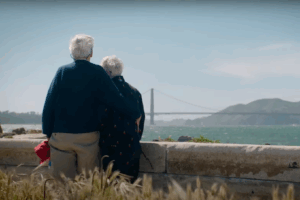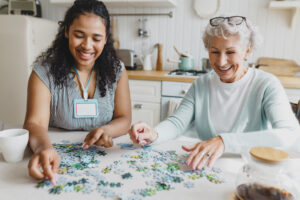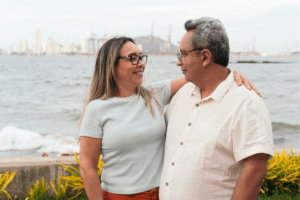Sometime around 75,000 years ago, a Neanderthal male suffered a broken leg. He was around 40-45, considered relatively old back then. We know his wound healed, a sure sign he was cared for by his fellow Neanderthals—in those days, a man who couldn’t walk would certainly die quickly without help. This first evidence of caring, those wordless millennia ago, is beautiful to think about. Archeologists also found potential evidence of a makeshift leg brace, but that is uncertain. If so, it might be the first piece of technology created solely for an older adult. And, for many, it may have seemed like the last.
If you have an aging loved one, you may have felt frustrated in recent years to see just how little of our technology boom has been marketed towards helping older adults—but that’s changing. Investors and inventors, especially younger Silicon Valley ones, are creating easy-to-use, app-based services that are transforming care and altering the way our loved ones grow older. They make it easier to age at home, and give relatives the peace of mind that their loved one is in good hands. Aging is, to use a term favored by startups and the tech press, being disrupted. Understanding how can help you offer the best possible support to the ones you love.
A Boom in the Population—And the Tech Market
It makes sense that the Eye of Silicon Valley has swung toward the older adult demographic. As Baby Boomers age, there has been an enormous market shift toward elderly care. Numbering in at 46 million, and counting, Americans over the age of 65 currently make up 14.1% of the population. By contrast, it was 12% in 1990 and just 4.1% in 1900—and I’m guessing, but can’t confirm, less than 1% for Neanderthals. By 2040, this population of aging adults will represent 20.1% of the US.
Clearly, there’s a market—and it’s one that is being targeted by dynamic new apps that help older adults safely age at home. These are devices that allow for health to be monitored remotely, and doctors to be consulted from the comfort of one’s sofa. A few of these incredible new applications include:
- Medication Management Technology. Adults between 65 and 79 can be prescribed, on average, 27 new medications each year. With varying days and dosages, that’s an enormous amount of precise scheduling to remember, and the ramifications of accidentally misusing a prescription can be severe, with sickness and even death as a consequence.
That’s why innovative apps like MyMedSchedule and Medisafe Medication Reminder help older adults, and their caregivers, stay on target with each bottle in the medicine cabinet. Helpful reminders, including for when it is time to refill a prescription, keep medication schedules on track, without having to remember just which ones you take on Wednesday, but not Thursday.
- Telehealth. One of the most frustrating and limiting parts of aging is being tied to doctors’ appointments. Having to go in for regular checkups, even when everything seems relatively fine, cuts into your loved one’s day, and their independence. Many older adults who can’t go on their own may feel guilty for asking family and friends to take them, and that can be a strain on a relationship.
Telehealth allows patients to use biometric technology to take vital measurements, from simple, wearable tech like heart-rate monitors to actual ingestible nanobots that can diagnose internal problems. These can then be securely transmitted to a doctor’s phone or tablet, allowing for a checkup to be done from the comfort of the patient’s home. Many people are also taking advantage of video services like Skype or Facetime to have direct consultations. This frees up so much time—and lets older adults take advantage of independent aging.
- Internet of Things Sensors. A caregiver may not be able to be at home with an older adult 24 hours a day, and even if one can, everyone eventually needs sleep. Internet of Things sensors, which are monitors or motion-capture devices connected to any internet-enabled phone, tablet, or computer, can be your “eyes and ears,” watching for changes in patterns or odd occurrences.
For instance, sensors on the wall can alert you if your aging loved one takes a fall, an internet-connected oven will let you know if it is turned on at an odd hour, or a shower hooked up to a monitor can let you or a caregiver know if the water has been running for longer than average. These devices let you monitor for signs of an accident from around the world, and act accordingly.
Using Tech to Your Advantage Seeking Caregivers
You may have noticed that all the apps and technologies mentioned involve caregiver help, but don’t help you find a quality caregiver—until now. The greatest fear a child has is not being sure about the caregiver they hire. They worry: what if I put my parent in a terrible situation.
The “not knowing” is a market inefficiency that some Silicon Valley inventors and venture capitalists aim to fix,—in a caring and compassionate way. Having knowledge that you are getting the very best when it comes to caring for your loved one is a relief for everyone involved. Startups like Santa Monica-based based HomeHero and San Francisco-based Honor look to connect older adults with highly-trained, highly-qualified, and (this is important) well-paid caregivers. Usually with help from one of an older adult’s grown children, they match up the right caregivers with the right families.
And, they may be cutting-edge apps, but they speak the language of compassion, talking about aging with “joy, comfort, and grace.” Honor vets their employees—and they are employees, not contractors, so there is a shared responsibility—and pays them well, above even California’s minimum wage. This means you are getting workers who are incentivized instead of stressed out about making ends meet.
Quality homecare means a greater sense of well-being for everyone. It means a better life for the caregiver, who has stability. It means a better life for you, knowing that the aging adults in your life are being taken care of. And it’s wonderful for the older adult, who can, with help from other recently-developed technologies, continue to explore the life they deserve. The new tech hitting the market today supports our aging loved ones so they are free to still be themselves—and to always be growing.
We don’t know if any words passed between the injured Neanderthal man and the people who took a look at him, took a look at themselves, and decided that he mattered. We don’t know if they had a word for love, or if they had any words at all. We don’t know the looks they exchanged that said “this is right”. But we know they understood that the lives of older adults mattered. That’s something our species shares with them, and with the new boom in senior-focused technology, we can honor that loving decision made one ancient, star-filled night, in our own, modern way.
At Institute on Aging, we believe that aging should be met with dignity, independence, and a sense of exploration. Connect with us today to learn more about our programs for older adults, their families, and their caretakers.






